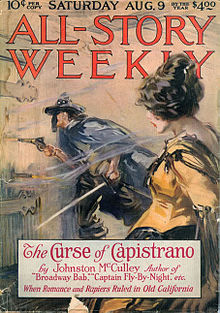
Back El Zorro AN زورو Arabic زورو ARZ Зора Byelorussian Зора BE-X-OLD Зоро Bulgarian Zorro Breton Zorro Catalan Zorro Czech Zorro Danish
This article needs additional citations for verification. (December 2018) |
| Zorro | |
|---|---|
 The Cover to The Curse of Capistrano by Johnston McCulley, The All-Story Magazine, August 9, 1919, featuring the character | |
| First appearance | All-Story Weekly (August 1919) |
| Created by | Johnston McCulley |
| Portrayed by |
|
| In-universe information | |
| Full name | Don Diego de la Vega |
| Occupation | Nobleman, vigilante |
| Weapon | |
| Nationality | Californian (New Spain or Mexico) |
Zorro (Spanish: [ˈsoro] or [ˈθoro], Spanish for "fox") is a fictional character created in 1919 by American pulp writer Johnston McCulley, appearing in works set in the Pueblo of Los Angeles in Alta California.[1] He is typically portrayed as a dashing masked vigilante who defends the commoners and Indigenous peoples of California against corrupt, tyrannical officials and other villains. His signature all-black costume includes a cape, a hat known as a sombrero cordobés, and a mask covering the upper half of his face.
In the stories, Zorro has a high bounty on his head but is too skilled and cunning for the bumbling authorities to catch, and he also delights in publicly humiliating them. Because of this, the townspeople started calling him "El Zorro" because of his foxlike cunning and charm. Zorro is an acrobat and an expert in various weapons. Still, the one he employs most frequently is his rapier, which he often uses to carve the initial "Z" on his defeated foes and other objects to "sign his work". He is also an accomplished rider, his trusty steed being a black horse called Tornado.
Zorro is the secret identity of Don Diego de la Vega (originally Don Diego Vega), a young man who is the only son of Don Alejandro de la Vega, the wealthiest landowner in California, while Diego's mother is dead. In most versions, Diego learned his swordsmanship while at university in Spain and created his masked alter ego after he was unexpectedly summoned home by his father because California had fallen into the hands of an oppressive dictator. Diego is usually shown living with his father in a vast hacienda, which contains many secret passages and tunnels leading to a secret cave that serves as headquarters for Zorro's operations and as Tornado's hiding place. To divert suspicion about his identity, Diego hides his fighting abilities while pretending to be a coward and a fop.
Zorro debuted in the 1919 novel The Curse of Capistrano, originally meant as a stand-alone story. However, the success of the 1920 film adaptation The Mark of Zorro starring Douglas Fairbanks and Noah Beery, which introduced the popular Zorro costume, convinced McCulley to write more Zorro stories for about four decades; the character was featured in a total of five serialized stories and 57 short stories, the last one appearing in print posthumously in 1959, the year after his death. The Curse of Capistrano eventually sold more than 50 million copies, becoming one of the best-selling books of all time. While the rest of McCulley's Zorro stories did not enjoy the same popularity, as most of them were never reprinted until the 21st century, the character also appears in over 40 films and in ten TV series, the most famous being the Disney production, Zorro, of 1957–1959 starring Guy Williams. Other media featuring Zorro include stories by different authors, audio/radio dramas, comic books and strips, stage productions, and video games.
Being one of the earliest examples of a fictional masked avenger with a double identity, Zorro inspired the creation of several similar characters in pulp magazines and other media and is a precursor of the superheroes of American comic books, with Batman and the Lone Ranger drawing particularly close parallels to the character.
- ^ Sragow, Michale (December 29, 2020). "Zorro at 100: Why the original swashbuckler is still the quintessential American action hero". The Washington Post. Retrieved January 2, 2021.